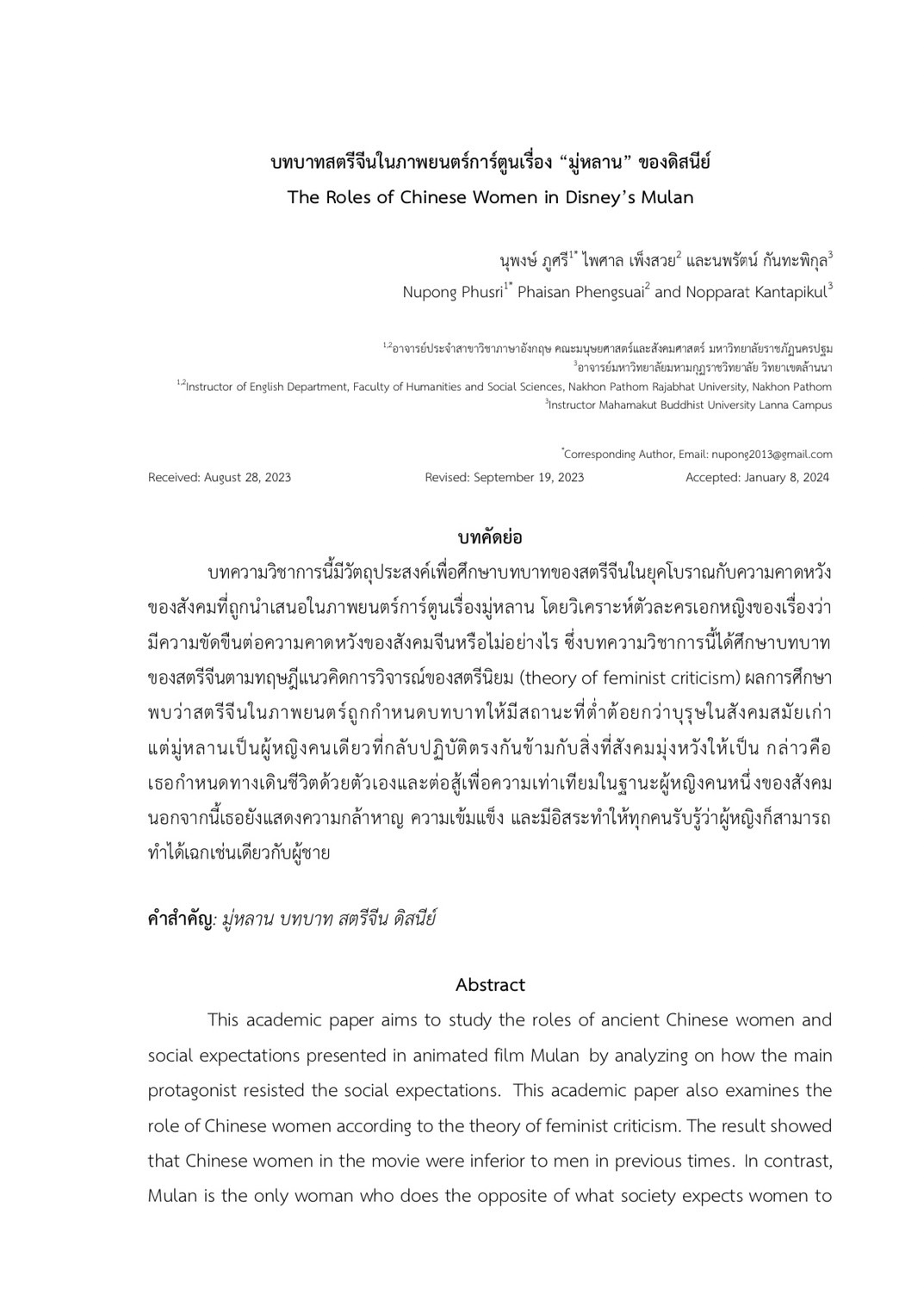บทบาทสตรีจีนในภาพยนตร์การ์ตูนเรื่อง “มู่หลาน” ของดิสนีย์
คำสำคัญ:
มู่หลาน , บทบาท, สตรีจีน , ดิสนีย์บทคัดย่อ
บทความวิชาการนี้มีวัตถุประสงค์เพื่อศึกษาบทบาทของสตรีจีนในยุคโบราณกับความคาดหวังของสังคมที่ถูกนำเสนอในภาพยนตร์การ์ตูนเรื่องมู่หลาน โดยวิเคราะห์ตัวละครเอกหญิงของเรื่องว่า มีความขัดขืนต่อความคาดหวังของสังคมจีนหรือไม่อย่างไร ซึ่งบทความวิชาการนี้ได้ศึกษาบทบาท ของสตรีจีนตามทฤษฎีแนวคิดการวิจารณ์ของสตรีนิยม (theory of feminist criticism) ผลการศึกษาพบว่าสตรีจีนในภาพยนตร์ถูกกำหนดบทบาทให้มีสถานะที่ต่ำต้อยกว่าบุรุษในสังคมสมัยเก่า แต่มู่หลานเป็นผู้หญิงคนเดียวที่กลับปฏิบัติตรงกันข้ามกับสิ่งที่สังคมมุ่งหวังให้เป็น กล่าวคือ เธอกำหนดทางเดินชีวิตด้วยตัวเองและต่อสู้เพื่อความเท่าเทียมในฐานะผู้หญิงคนหนึ่งของสังคม นอกจากนี้เธอยังแสดงความกล้าหาญ ความเข้มแข็ง และมีอิสระทำให้ทุกคนรับรู้ว่าผู้หญิงก็สามารถทำได้เฉกเช่นเดียวกับผู้ชาย
References
กันตพงศ์ ก้อนนาค. (2563). วิเคราะห์ตัวตน ‘มู่หลาน’ ที่ดิสนีย์สร้างให้แตกต่างจากตัวละคร (เจ้า)หญิงอื่น ๆ’. บริษัท มติชน จำกัด. https://www.silpa-
mag.com/culture/article_48513
ทศพร กลิ่นหอม. (2566). ‘มู่หลาน ย้อนตำนานวีรสตรีผู้ถูกนำมาเป็นสัญลักษณ์ของการรัก ชาติ’. Sarakadee Lite.
https://www.sarakadeelite.com/faces/mulan-history
Bancroft, T. & Cook, B. (1998). Mulan. Buena Vista Pictures.
Curtin, K. (1975). Women in China. Pathfinder Press.
Davis, S. (1994). The idea of women in renaissance literature. MacMillan.
Lorber, J. (1998). Gender inequality: Feminist theories and politics. Roxberry Publishing Company.
Fei, Hsiao-Tung. (1980). Peasant life in China. Routledge & Kegan Paul.
Salden, M. (2019). Disney’s damsels: A representation of femininity in Disney’s animated movies Snow White, Mulan, and Brave.
Radboud University Nijmegen.
Thinhanwong, S. (2009). The resistance to Chinese social expectations of the main female character in animated films: Mulan and
Mulan II [Master’s thesis]. Srinakharinwirot University.

Downloads
เผยแพร่แล้ว
How to Cite
ฉบับ
บท
License
Copyright (c) 2025 วารสารวิชาการมนุษยศาสตร์และสังคมศาสตร์ มหาวิทยาลัยราชภัฏนครปฐม

This work is licensed under a Creative Commons Attribution-NonCommercial-NoDerivatives 4.0 International License.
วารสารวิชาการมนุษยศาสตร์และสังคมศาสตร์ มหาวิทยาลัยราชภัฏนครปฐม




